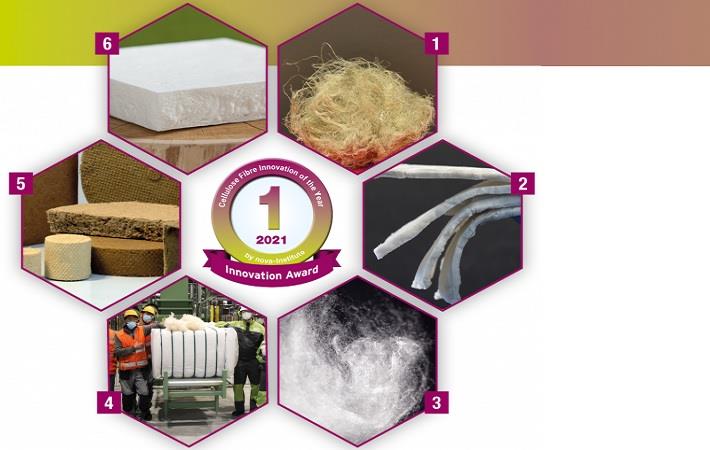Interviews
6 inventions nominated for Cellulose fibre award
25 Dec '20
4 min read

Pic: Cellulose Fibre
Six inventions including plastic-free absorbent hygiene products and Cellulose nanofibre assisted biomimetic aerogels for EMI shielding have been nominated for the “Cellulose Fibre Innovation Award”. Of these, three winners will be selected and awarded at the 2nd International Conference on Cellulose Fibres (CCF), to be held during February 2–3, 2021 online.
For the first time ever, the innovation award “Cellulose Fibre Innovation of the Year” will be granted to the innovative cellulose fibre industry for the development of new technologies and applications.
Cellulose fibres are the fastest growing fibre group in textiles, the largest investment sector in the bio-based economy, and a solution for avoiding microplastics. Producers and inventors along the entire value chain from feedstock to the final product joined the competition.
Out of twelve inventions six have been finally nominated for the award. The selection was made by a jury consisting of Nova Institute employees and the advisory board of the conference. The audience will elect the three winners at the 2nd International Conference on Cellulose Fibres.
Bast Fibre Tech (Canada) has been nominated for making compostable fibre products from agricultural hemp and flax waste. Using biogenic waste from the production of fast-growing crops instead of using wood or fossil resources is environmentally and economically more sustainable. Applications for the obtained fibre with moisture absorbing properties are for example toilet paper and recyclable, thus flushable cleaning wipes.
Empa – Laboratories for Materials Science and Technology (Switzerland) has been nominated for its cellulose nanofibre assisted biomimetic aerogels for EMI shielding. Empa researchers combined cellulose-based aerogels with silver nanowires. The flexible composite blocks high-frequency electromagnetic radiation, which is traditionally achieved by using inflexible metal sheets or metallised foils. This ultra-light electromagnetic shielding material can be used to protect electronic components or the transmission of signals from electromagnetic fields caused by neighbouring electronic devices or motors.
Kelheim Fibres (Germany) has created plastic-free absorbent hygiene products. Kelheim Fibres developed plant-based fibre solutions for absorbent hygiene products. These comprise speciality fibres for the single layers of AHP with different functionalities: a hydrophobised fibre for the topsheet, a trilobal fibre for the acquisition/distribution layer and a hollow fibre for the absorbent core. These biodegradable and sustainably manufactured fibres enable the replacement of plastic fibres without a loss of performance. The material has the potential to be used also for the production of textiles, such as reusable menstrual underwear. First commercial end-products using Kelheim’s fibre solutions are developed and intended to be launched in 2021.
Metsä Spring (Finland) has created textile fibre based on paper grade pulp. The Metsä Group is developing a more energy-efficient process based on a new solvent family to produce Man-Made Cellulosic Fibre (MMCF). Using ionic liquids, the MMCF can be produced from paper-grade pulp, avoiding the use of energy-intensive dissolving pulp. MMCF, such as viscose, lyocell or Modal, are important fibres for the textile industry.
OrganicDisposables (Poland) has created FibriTech – a porous and light material from cellulose for soilless farming. FibriTech is a new process for the production of porous and light material from cellulose and lignocellulose. A mixture of fibres can be used, including waste and recycled fibres. This extends the possible feedstock for usable materials and reduces waste. Desired properties are derived by the application of bio-additives. The resulting material can be used as a natural soilless substrate with favourable properties for both plants and soilless farming systems. Other possible applications are thermal and sound insulators and air filters.
Stora Enso (Sweden) has produced a lightweight cellulose-based foam for packaging. "Cellulose Foam by Stora Enso" is designed as an eco-friendly alternative for fossil-based packaging and cushioning materials such as expanded polystyrene or polyethylene. The foam has comparable shock-absorbing and insulating properties whilst being bio-based, biodegradable, compostable and recyclable in ordinary paper recycling.
The “2nd International Conference on Cellulose Fibres” will cover the entire value chain from lignocellulosic feedstock, dissolving pulp, cellulose fibres – such as rayon, viscose, Modal(R), lyocell or new developments – to a wide range of applications, woven textiles (clothing) and non-wovens (wipes and technical applications).
For the first time ever, the innovation award “Cellulose Fibre Innovation of the Year” will be granted to the innovative cellulose fibre industry for the development of new technologies and applications.
Cellulose fibres are the fastest growing fibre group in textiles, the largest investment sector in the bio-based economy, and a solution for avoiding microplastics. Producers and inventors along the entire value chain from feedstock to the final product joined the competition.
Out of twelve inventions six have been finally nominated for the award. The selection was made by a jury consisting of Nova Institute employees and the advisory board of the conference. The audience will elect the three winners at the 2nd International Conference on Cellulose Fibres.
Bast Fibre Tech (Canada) has been nominated for making compostable fibre products from agricultural hemp and flax waste. Using biogenic waste from the production of fast-growing crops instead of using wood or fossil resources is environmentally and economically more sustainable. Applications for the obtained fibre with moisture absorbing properties are for example toilet paper and recyclable, thus flushable cleaning wipes.
Empa – Laboratories for Materials Science and Technology (Switzerland) has been nominated for its cellulose nanofibre assisted biomimetic aerogels for EMI shielding. Empa researchers combined cellulose-based aerogels with silver nanowires. The flexible composite blocks high-frequency electromagnetic radiation, which is traditionally achieved by using inflexible metal sheets or metallised foils. This ultra-light electromagnetic shielding material can be used to protect electronic components or the transmission of signals from electromagnetic fields caused by neighbouring electronic devices or motors.
Kelheim Fibres (Germany) has created plastic-free absorbent hygiene products. Kelheim Fibres developed plant-based fibre solutions for absorbent hygiene products. These comprise speciality fibres for the single layers of AHP with different functionalities: a hydrophobised fibre for the topsheet, a trilobal fibre for the acquisition/distribution layer and a hollow fibre for the absorbent core. These biodegradable and sustainably manufactured fibres enable the replacement of plastic fibres without a loss of performance. The material has the potential to be used also for the production of textiles, such as reusable menstrual underwear. First commercial end-products using Kelheim’s fibre solutions are developed and intended to be launched in 2021.
Metsä Spring (Finland) has created textile fibre based on paper grade pulp. The Metsä Group is developing a more energy-efficient process based on a new solvent family to produce Man-Made Cellulosic Fibre (MMCF). Using ionic liquids, the MMCF can be produced from paper-grade pulp, avoiding the use of energy-intensive dissolving pulp. MMCF, such as viscose, lyocell or Modal, are important fibres for the textile industry.
OrganicDisposables (Poland) has created FibriTech – a porous and light material from cellulose for soilless farming. FibriTech is a new process for the production of porous and light material from cellulose and lignocellulose. A mixture of fibres can be used, including waste and recycled fibres. This extends the possible feedstock for usable materials and reduces waste. Desired properties are derived by the application of bio-additives. The resulting material can be used as a natural soilless substrate with favourable properties for both plants and soilless farming systems. Other possible applications are thermal and sound insulators and air filters.
Stora Enso (Sweden) has produced a lightweight cellulose-based foam for packaging. "Cellulose Foam by Stora Enso" is designed as an eco-friendly alternative for fossil-based packaging and cushioning materials such as expanded polystyrene or polyethylene. The foam has comparable shock-absorbing and insulating properties whilst being bio-based, biodegradable, compostable and recyclable in ordinary paper recycling.
The “2nd International Conference on Cellulose Fibres” will cover the entire value chain from lignocellulosic feedstock, dissolving pulp, cellulose fibres – such as rayon, viscose, Modal(R), lyocell or new developments – to a wide range of applications, woven textiles (clothing) and non-wovens (wipes and technical applications).
Fibre2Fashion News Desk (SV)
Popular News
Leave your Comments
Editor’s Pick
































-Ltd..jpg?tr=w-120,h-60,c-at_max,cm-pad_resize,bg-ffffff)





.jpg?tr=w-120,h-60,c-at_max,cm-pad_resize,bg-ffffff)
.jpg?tr=w-120,h-60,c-at_max,cm-pad_resize,bg-ffffff)






